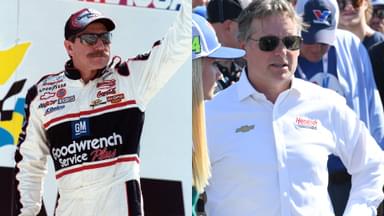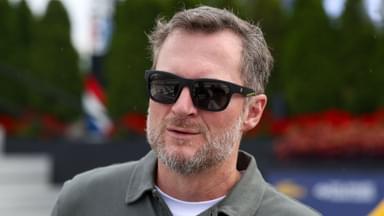Over the years, NASCAR’s annual race at Indianapolis Motor Speedway has had a number of different sponsor names. But to race fans, it has been and always will be known simply as “The Brickyard 400”, sponsor names be damned.
Advertisement
From the first time a stock car took to the hallowed ground of the 2.5-mile oval during a two-day tire test — June 22-23, 1992 — to the failed three-year experiment of switching to IMS’s infield road course (aka the “Indianapolis Grand Prix Circuit), and then back to the oval, there have been numerous highlights … and lowlights.
Sunday will mark the 32nd edition of the Brickyard 400.
It all started with the nine drivers who took part in the 1992 tire test, followed by yet another test the following year that featured more than a dozen drivers. And then NASCAR made the fateful decision to finally hold a race on the most famous racetrack in the world
“It was August 6th, 1994, the first ever running of the Brickyard 400,” veteran NASCAR announcer Doug Rice said. “It got off to a roaring success with the beloved Jeff Gordon coming home with his second career win.
“And the next thing you know, we’re racing (every year) at the famed Indianapolis Motor Speedway.”
On this week’s edition of Fast Talk on the Performance Radio Network, Rice’s co-host and former NASCAR driver and current analyst, Kyle Petty, spoke at length about the Brickyard’s history.
“You used the word ‘event,'” Petty said to Rice. “That’s what it was. They hyped it as an event. They didn’t really hype it as a race. It was like NASCAR is coming to Indy. That was an event for us to go up there.
“When we went up there and did the tire test (in 1992), and it was (Dale) Earnhardt and Davey (Allison), and Ernie Irvan) (along with Rusty Wallace, Ricky Rudd, Mark Martin, Bill Elliott, Darrell Waltrip, and Kyle Petty),” The son of Richard Petty said. “There was like 30 or 40,000 fans in the stands for a tire test, for a two-day tire test.
“So yeah, I don’t think there’s anything that’s come along in the sport as far as from a track perspective – even going to the streets of Chicago (or) going to Mexico City. No event was hyped like that event was.”
Jeff Gordon: Hometown Boy Does Good
It was quite fitting that Gordon would win the inaugural Brickyard 400 on August 6, 1994. After growing up on the West Coast, Gordon and his family moved to tiny Pittsboro, Indiana, just 16 miles away from the iconic IMS, to take his dirt racing career to the next level.
But Gordon quickly found his way to the NASCAR world, and the rest is history as the Brickyard 400 went on to become one of the most popular races on the Cup schedule, but also became one of the sport’s four “Crown Jewels”: the Daytona 500, Coca-Cola 600, Southern 50,0, and the Brickyard 400.
“Having Jeff win that first event, when he goes up there and wins that first event, that solidified its place (in NASCAR history),” Petty said. “That solidified it as this is big.”
But Petty was also one of the few naysayers about NASCAR’s decision to race at Indy.
“I was against it from the very beginning, and that shows what side of history I come down on because it had no stock car history, it had no NASCAR history, we were walking into someone else’s history,” Petty said. “We were walking into open-wheel history just as if they came to Daytona, they walk into Bill France Sr., to Fireball Roberts, to Smokey Yunick, to Lee Petty, to that history.
“It was a little bit different, and we made a tradition of it.”
Gordon’s breakthrough win at Indy came just eight races after his first-ever Cup win in the Coca-Cola 600. The win at Indy would be his second Cup triumph, and he’d go on to win 93 races in his career, third-most in NASCAR history.
Gordon told the Indianapolis Star last year what his inaugural Brickyard 400 win meant for him and ultimately meant long-term to his career.
“The emotions at (the Coca-Cola 600) were about a lot of accomplishment through a lot of hard work and feeling like I’d made it,” Gordon said. “(Winning) Indy was more of an accomplishment of a dream beyond belief, and kinda, ‘Hey, I’ve not just made it. I’m taking things to the next level,’
“This win was the launching pad for myself, my team, and the whole sport, and I definitely felt that. I’ve said for many, many years that that day changed my life. I went from a kid trying to make it at the highest level of North American stock car racing, to not just making it, but ‘I’ve arrived.’”
Moving the Brickyard 400 to Indy’s Road Course: A HUGE mistake
Then, NASCAR and IMS decided to move the Brickyard 400 to the track’s infield road course in 2021, almost the same identical layout as the Formula One race that was held at IMS for only eight years (2000-2007), including the massive failure of the 2005 race — known as “the Michelin Tire Controversy”, when only six cars took part in the event.
Fans hated the road course so much that attendance dropped significantly. That’s why the road course race had a brief three-year history before NASCAR and IMS brought the 400 back to its roots on the IMS oval.
“When they switched off and they run the road course, they broke the tradition,” Petty said of NASCAR and IMS. “So, now it’s just Indianapolis to me. We’re going to Indianapolis. It’s a great place. It’s a place for motorsports, the history there, what (track owner Roger) Penske’s done, what all that stuff.
“But it lost a little bit of that luster when it went to the road course for me because it went away from what I thought it was intended to do for the sport.”
Gordon would go on to win a record five Brickyard 400s, while former teammate Jimmie Johnson would win the next most, four. Dale Earnhardt would also win the 400, but just once, in its second year in 1995.
And then another Indiana product, Tony Stewart, would win it twice in 2005 and 2007.








